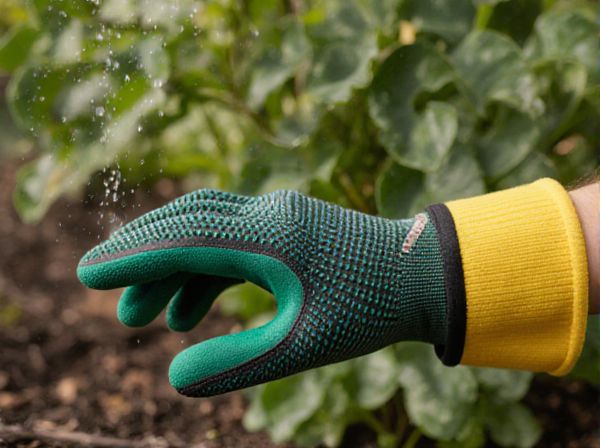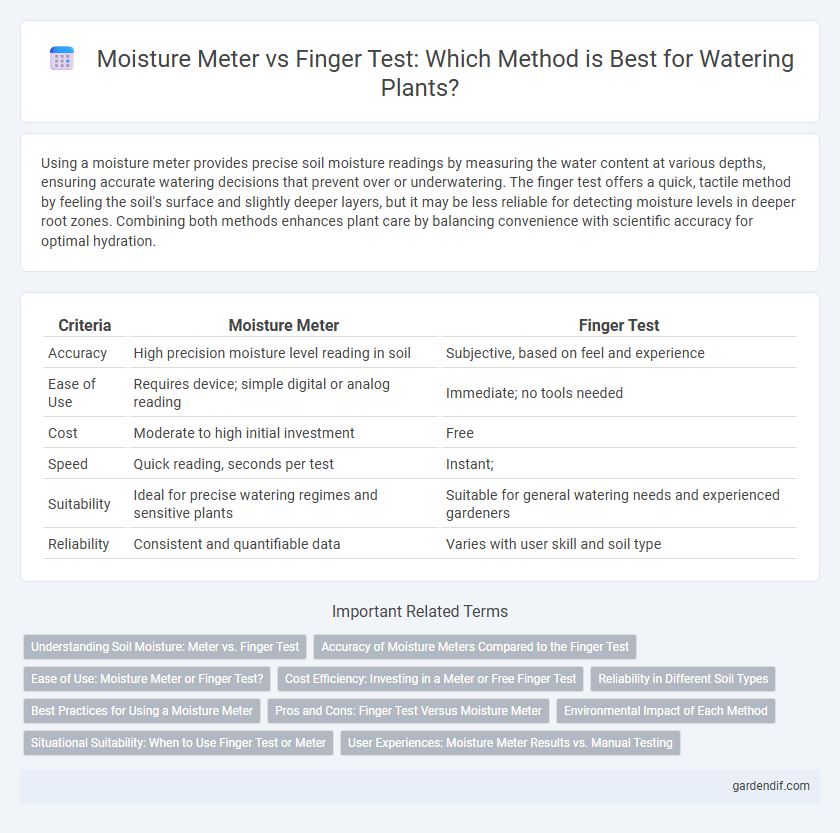
Moisture meter use vs Finger test Illustration
Using a moisture meter provides precise soil moisture readings by measuring the water content at various depths, ensuring accurate watering decisions that prevent over or underwatering. The finger test offers a quick, tactile method by feeling the soil's surface and slightly deeper layers, but it may be less reliable for detecting moisture levels in deeper root zones. Combining both methods enhances plant care by balancing convenience with scientific accuracy for optimal hydration.
Table of Comparison
| Criteria | Moisture Meter | Finger Test |
|---|---|---|
| Accuracy | High precision moisture level reading in soil | Subjective, based on feel and experience |
| Ease of Use | Requires device; simple digital or analog reading | Immediate; no tools needed |
| Cost | Moderate to high initial investment | Free |
| Speed | Quick reading, seconds per test | Instant; |
| Suitability | Ideal for precise watering regimes and sensitive plants | Suitable for general watering needs and experienced gardeners |
| Reliability | Consistent and quantifiable data | Varies with user skill and soil type |
Understanding Soil Moisture: Meter vs. Finger Test
A moisture meter offers precise soil moisture readings by detecting water content at various depths, enabling accurate watering schedules for plants. The finger test, while intuitive and cost-free, provides only a surface-level estimate, which can lead to inconsistent watering and potential plant stress. Using a moisture meter improves water efficiency and plant health by delivering data-driven insights into soil moisture levels compared to the subjective finger test.
Accuracy of Moisture Meters Compared to the Finger Test
Moisture meters provide precise, quantitative readings of soil moisture levels, offering greater accuracy than the subjective finger test. These devices detect moisture content at various soil depths, minimizing errors caused by surface dryness or inconsistent tactile perception. Unlike the finger method, moisture meters deliver reliable data critical for optimal watering decisions, improving plant health and water conservation.
Ease of Use: Moisture Meter or Finger Test?
Using a moisture meter provides precise readings, making it easier for gardeners to monitor soil hydration accurately without guesswork. The finger test offers a quick, tactile method but can vary in reliability depending on soil type and user experience. Moisture meters streamline watering decisions by delivering consistent data, enhancing ease of use in plant care routines.
Cost Efficiency: Investing in a Meter or Free Finger Test
Using a moisture meter provides precise soil moisture readings, reducing the risk of overwatering and plant stress, which can save money on plant replacement and water bills over time. While finger testing is free and accessible, it often lacks accuracy, potentially leading to costly errors such as root rot or dehydration. Investing in a quality moisture meter offers long-term cost efficiency by optimizing watering schedules based on exact moisture levels.
Reliability in Different Soil Types
Moisture meters provide consistent and accurate readings across various soil types, including sandy, clay, and loamy soils, by measuring volumetric water content with sensors. The finger test, while intuitive, often lacks precision and can misjudge moisture levels, especially in dense or compacted soils where surface feel doesn't reflect deeper moisture. Using a moisture meter ensures reliable moisture assessment, leading to more effective watering decisions and healthier plant growth regardless of soil texture.
Best Practices for Using a Moisture Meter
Using a moisture meter provides accurate and consistent readings of soil moisture levels compared to the subjective finger test, which can vary based on individual perception. For best results, insert the moisture meter probe at root level in multiple spots around the plant to get a representative average and avoid compacted or overly dry areas that may skew readings. Regular calibration of the device and cleaning the probes after each use ensure precise measurements and prolong the moisture meter's lifespan.
Pros and Cons: Finger Test Versus Moisture Meter
The finger test provides a quick, cost-free method to estimate soil moisture but lacks precision and can be influenced by soil type and user experience. In contrast, a moisture meter offers more accurate, consistent readings by detecting volumetric water content, though it requires initial investment and occasional calibration. Using both methods together can enhance watering decisions, balancing practicality with data-driven accuracy.
Environmental Impact of Each Method
Using a moisture meter reduces water waste by providing precise soil moisture readings, which helps optimize irrigation and conserve water resources. In contrast, the finger test is less accurate, often leading to overwatering and increased water consumption. Moisture meters also minimize environmental damage by promoting sustainable watering practices that protect soil health and reduce runoff.
Situational Suitability: When to Use Finger Test or Meter
The finger test is ideal for quick, casual checks of soil moisture in houseplants or small garden beds where tactile feedback is sufficient. Moisture meters provide more precise, quantitative readings, making them essential for sensitive plants, large-scale gardening, or situations requiring consistent monitoring of soil moisture levels. Choosing between the finger test and a moisture meter depends on the plant type, soil complexity, and the need for accuracy in watering decisions.
User Experiences: Moisture Meter Results vs. Manual Testing
Moisture meters provide precise quantitative data on soil moisture levels, allowing users to avoid overwatering or underwatering plants based on accurate readings. In contrast, manual testing through the finger method offers a more subjective assessment, often leading to inconsistent results due to varying user experience and perception. Users report higher confidence and consistency in care routines when relying on moisture meters compared to the sometimes guesswork-dependent finger test approach.
Moisture meter use vs Finger test Infographic

 gardendif.com
gardendif.com